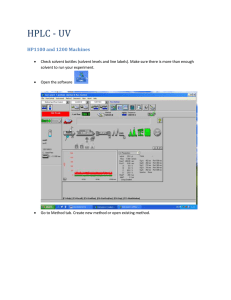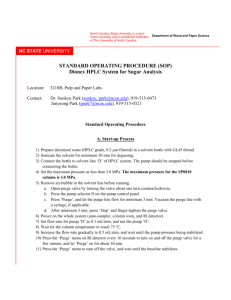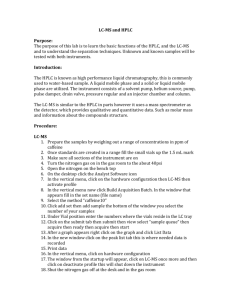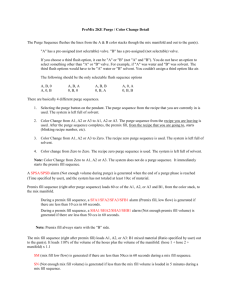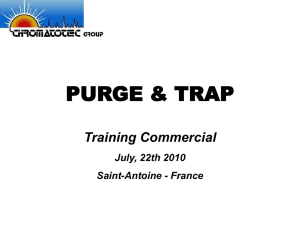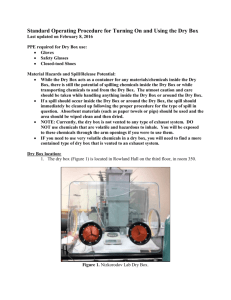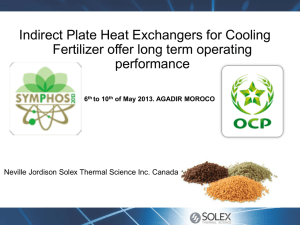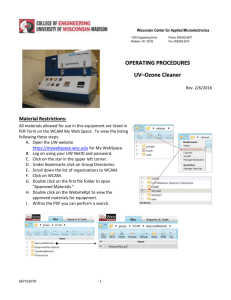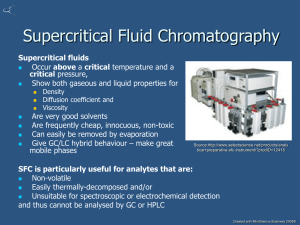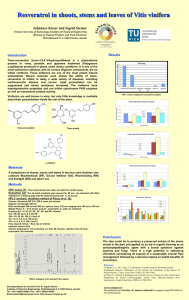Hamilton Regional Laboratory Medicine Program
advertisement
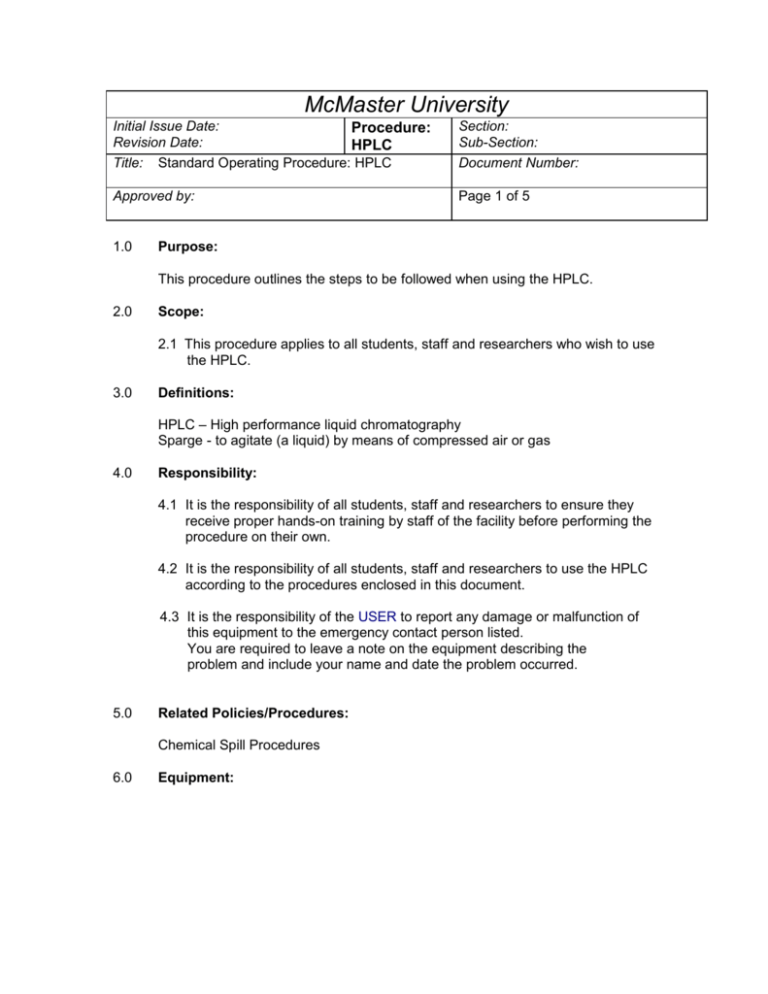
McMaster University Initial Issue Date: Procedure: Revision Date: HPLC Title: Standard Operating Procedure: HPLC Section: Sub-Section: Document Number: Approved by: Page 1 of 5 1.0 Purpose: This procedure outlines the steps to be followed when using the HPLC. 2.0 Scope: 2.1 This procedure applies to all students, staff and researchers who wish to use the HPLC. 3.0 Definitions: HPLC – High performance liquid chromatography Sparge - to agitate (a liquid) by means of compressed air or gas 4.0 Responsibility: 4.1 It is the responsibility of all students, staff and researchers to ensure they receive proper hands-on training by staff of the facility before performing the procedure on their own. 4.2 It is the responsibility of all students, staff and researchers to use the HPLC according to the procedures enclosed in this document. 4.3 It is the responsibility of the USER to report any damage or malfunction of this equipment to the emergency contact person listed. You are required to leave a note on the equipment describing the problem and include your name and date the problem occurred. 5.0 Related Policies/Procedures: Chemical Spill Procedures 6.0 Equipment: ____________________________________________________________________________ 7.0 Action/Decision-making Framework: PROCEDURE STEPS 7.1 Pre-use check 7.2 Turn on WORK INSTRUCTIONS .1 Inspect electrical connections and hook up to recommended electrical supply. .2 Use only HPLC-grade solvents or filtered buffers. .1 .2 .3 7.3 7.4 Sparge Purge the Reservoir Lines Turn on the power switch. After initialization is complete, press the Set Up function button. Turning on the power automatically turns on the UV source. .1 Turn on the helium tank. The pressure must be between 50 -150 psi. .2 Check the Reservoirs to sparge. Move the cursor with the arrow keys to position it over the Enabled/Disabled space for reservoir A, and set it appropriately. It is Enabled by pressing 1 followed by the Enter key, and Disabled by pressing 0 followed by the Enter key. Enable each reservoir you plan to use, and disable the others. This does not start the sparging process, but prepares for it. .3 Start sparging. Press the Direct function button to get to the Direct Control screen. Use the arrow keys to get to the Sparge section and set the rate for 100 ml/min. Let the helium flow at this rate for 20 minutes while you finish the setup. .1 Enter 100% for the eluent line you wish to purge and 0% for all other lines. Repeat for all solvents. Start Autoprime screen key to start the autoprime. The syringe fits into the Luer lock on the black knob inside the front of the instrument. After attaching the syringe, turn the knob counterclockwise from Run .2 .3 .4 RATIONALE To avoid particulate contamination. PROCEDURE STEPS WORK INSTRUCTIONS to Draw and withdraw 10-20 mL of the eluent, then turn the knob clockwise to inject and re-inject the eluent. This should be done for each reservoir to be used. Push the Start Prime screen key to restart the prime if you don’t finish in one prime cycle. TAKE CARE not to flow immiscible eluents one after the other. 7.5 7.6 Purge the Autoinjector and Perform Compression Check Routine Operation .1 Press the Direct button and enter vial number 1 for both initial and final vials by using the arrow keys to move the cursor to the appropriate fields and then typing 1 followed by Enter. .2 Press the Set Up function button and then the Next Setup screen key to get to the Autoinjector Setup screen. Press the Purge Page screen key to get to the purge. Using the arrow keys, set the time to 1 minute and press Enter. .3 Turn off the compression check by typing 0 followed by Enter while on the compression check line. .4 Hit the Start screen key. The purge will take longer than one minute, and finally will put up a screen saying Purge Complete. At this point, redo the purge (press Redo Purge screen key). .5 After two purges have been done, press the Return screen key and change the compression check to Yes by moving to that line with the arrows and typing 1 followed by Enter. Then start the purge for the third and final time. .6 When complete, note the test results in the log book and press the Return screen key until you get back to a setup screen. .1 Press the Direct function button, and turn the sparge rate down to a more suitable value (i.e. 30 mL/min for aqueous and methanol, 15-20 for aqueous and acetonitrile, and 10-15 for aqueous alone.) RATIONALE PROCEDURE STEPS WORK INSTRUCTIONS .2 .3 .4 .5 7.7 7.8 Shutdown Safety Set up computer for data acquisition. Set proper operating conditions for your experiment, including percent mixture of the available eluents, the sparge rate, the flow rate, the injection volume, the total experiment time, detector wavelength, and the sample vial numbers. CAUTION: When changing solvent compositions, beware of miscibility problems! Verify the new solvent composition when you are done. Press the Start Prime screen key to start the two minute autoprime. Press the Start Run screen key to begin the experiment. .1 Overnight: Flush the system with HPLCgrade solvents. This is most easily done by priming the pump to flush the lines. Since the prime bypasses the column, it is also necessary to run the system for 510 minutes to flush the column. CAUTION: Do not flush with solvents which are not miscible with the eluents used in the experiment, and do not use the prime function when doing ion chromatography. The final flush should be with methanol, assuming the column is a reverse phase column such as C-18. Follow manufacturer’s guidelines for other types of columns. .2 Turn off the main valve on the helium gas tank. .3 Turn off the power switch. .1 All those using the equipment must wear the appropriate personal protective equipment. This should include lab coats and gloves. Wear UV blocking eye protection when aligning or changing UV lamps. Switch off power and unplug before servicing to avoid exposure to high voltages or moving parts. In general, HPLC equipment is safe under normal use, but care should be taken to .2 .3 .4 RATIONALE PROCEDURE STEPS WORK INSTRUCTIONS RATIONALE allow sufficient cooling time when changing columns and to take suitable precautions when handling flammable solvents. 8.0 Documentation: Record use in log book 9.0 References: Instrument Manual Template provided by Hamilton Health Sciences: Anatomical Pathology Department- McMaster University Medical Center. 10.0 Developed By in Consultation With: FHSc. Safety Office
